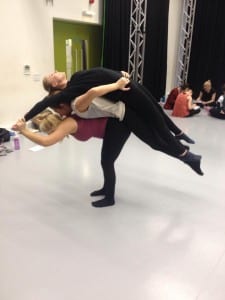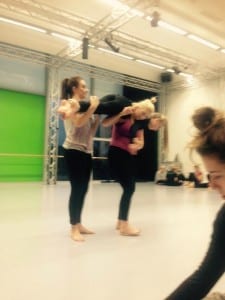My groups focus for this week was the question ‘Is it possible to do lifts with the same intention and fluidity in trios that it is in duets?’. From our own experiences in contact improvisation we have discovered that it is easier to perform lifts in a duo than in a trio, as it always seems that the third person who is trying to incorporate themselves in the lift gets left out. Therefore we wanted to explore this idea further in our groups and experiment with easier ways to perform a lift in a trio without making it feel clumpy. Our research lab included experimenting with lifts that we had previously learnt in class but we adapted and developed them to integrate a third person, which led to a concluding improvisation jam to demonstrate our discoveries that we made during the lesson. This lifts that we explored in relation to our questions were the back bend lift, the crucifix and the hip to hip lift.
Firstly, we experimented with incorporating a third person into the back bend lift. We attempted this by seeing if we could have two people as the base rather than one whilst they took the weight of the over dancer. Initially, this worked well with Ellie and I being the bases and Becky being the over dancer but it appeared to be quire difficult when Beth and Ellie were the bases because of the vast height difference. However, we discovered that it was important for both people as the under dancers to be positioned equally by ensuring their pelvis were at equal heights so therefore height and position was an important factor in making this lift effective. As the under dancer I could feel that the over dancer felt uncomfortable until we altered our position and it became easier for us all to perform the lift. To develop this we tried to experiment with a different way of incorporating three people into the back bend lift by one person taking the majority of the weight. This involved one person resting their torso on the back of the under dancer to carry the weight of the over dancer on their back but they also became the over dancer as the weight was transferred on the back of the third person as two people were lifted off the ground by the third person creating the supportive, stable base and the under dancer. This lift was more successful than the previous attempt, as a new, interesting lift was created but the over dancer had to ensure they create a strong base.
Another lift that we explored was the crucifix lift. This was adjusted and developed from the original lift of when one person would be held underneath their armpits by their partner, as they jumped up in the air and were pulled back into the space by their partner. This lift was developed by one person supporting the over dancer by the shoulder blades and incorporating a third person into the lift to support the weight. Personally, I felt that this lift was not as successful as the others because it appeared not the have as much fluidity as the others and we found it difficult to get out of the lift and bring the over dancer back to the group again. One reason we discovered for this is that the third person tends to support the weight by holding onto the over dancer’s leg, which limits their movement as they are restricted to where they can move to so it is difficult for them to position themselves to get out of the lift and this result in the lift looking less fluid. Finally, we experimented with the hip to hip lift and we adapted this differently to integrate three people in it. The weight was not supported by the hips but the shoulders. This involved one person taking the weight of the over dancer and transferring the weight of the over dancer into the third person so the lift can work as a trio. Originally, we discovered that this lift consisted of one person taking the majority of the weight and the third person just supporting so it wasn’t as effective as we hoped. Therefore, we decided that to incorporate three people into this lift, one person could perform the lift with another person, creating a duo and then transferring the weight of the over dancer into the third persons arms so they then become the under dancer and then they carry on the improvisation or turn it into another lift. We found this was more successful than trying to attempt lifts with two people being a supportive base and having one over dancer.
Once we had explored and experimented with these lifts, we performed a short improvisation jam to communicate our discoveries. To begin with we found that we were not looking for opportunities for contact but instead we were just rushing into a clump in the space and forcing a trio out of that. However, we then realised that we should not think about it and if there is a moment for contact we should not rush it but work with it to see where it could take us. Similar to experimenting with the hip to hip lift, we found that as soon as contact occurred the third person would support the weight of the over dance with their hands by holding their legs and this restricted the movement available for the over dancer. Therefore, we attempted the jam again and paid specific attention to this idea and instead of using arms for support we tried to use different body parts other than the hands and arms, which in turn made the contact more interesting but also didn’t limit movement as more opportunities were created. As a result, we found that lifts could include three people in a variety ways but it is primarily up to listening to other people’s bodies and having spatial awareness at all times.
As a group we formulated a series of questions in relation to our contact research lab:
Can you interchange the role of the lifter and who is being lifted?
Can you pass on the weight of the lift from one person to another?
How can you explore lifts in trios without resorting to to grabbing the legs as a way of support?
How can trio lifts initiate from the floor and move upwards and travel across the space?
This weeks jam was completely different to the previous jams I have been involved in, as it consisted of being blindfolded so no of the class knew where they were in the space or who they were working with. Initially, I was very hesitant to do this because I strongly dislike performing with my eyes closed but I found myself easing into it and creating new movements. It was interesting to step out and watch the group perform in a blind folded jam as some parts looked choreographed but of course they weren’t as no one knew where they were in the space. As no one could see, it was evident that people were’t thinking about what they were doing but instead if they felt a bit of contact they took it as an invitation and moved with it, which resulted into something intriguing. It was clear that people were using different body parts to initiate movements, creating new surfaces and different ways of moving were constructed.


